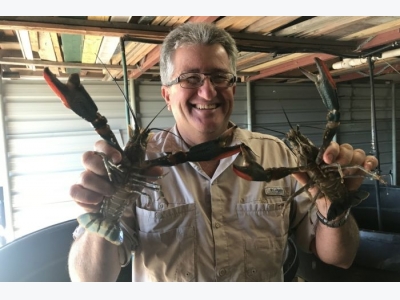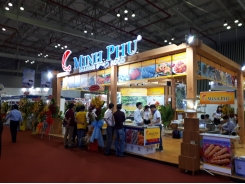Redclaw crayfish industry struggles to meet booming demand, but dry conditions make it hard

Andrew Gosbell says the demand for redclaw crayfish far outstrips production. (ABC Rural: Jennifer Nichols)
When Andrew Gosbell established his redclaw crayfish farm at Wolvi, near Gympie in 1997 he was ridiculed for his decision.
"I'm a commercial fisherman and they all said 'You'll never sell these guys'. We were getting around $6 a kilogram," he said.
The industry has had its ups and downs but now an estimated 30 Queensland redclaw crayfish growers cannot keep up with growing Australian and international demand for the freshwater aquaculture species that is raised in netted ponds to keep out predators.
"They've become really popular. As seafood gets harder to get they've become a consistent live animal that people know is fresh and clean," Mr Gosbell said.
"We've just now got to the stage in the industry where we can't keep up with supply.
"In Sydney and places like that we average around $30/kg wholesale, so I suppose you're talking $40/kg if not more retail.
"The industry's come full circle and it's great," Mr Gosbell said.

A tub of redclaw crayfish in the foreground with Andrew Gosbell further down in the dam.
To harvest redclaw crayfish the dam is drained and the crustaceans march up a ramp into a tank. (ABC Rural: Jennifer Nichols)
Queensland Crayfish Farmers Association president John Stevenson said hard lessons have been learnt from the 1990s boom period, when many people launched themselves into redclaw farming without sufficient forethought, advice, experience, financial backing, or knowledge.
"The state's production peaked in 2006 at 106 tonnes and fell to 30 tonnes following the demise of dozens of small farms that proved unviable," Mr Stevenson said.
"It is currently around 45 tonnes per annum and climbing steadily due to improved farming methods and feed developed as a result of an ongoing industry research program, which started 10 years ago.
"The potential is virtually unlimited. At least once a month I get international enquiries in the order of a tonne a week, quite apart from the unsated demand in Australia."

A close up of lots of redclaw crayfish.
Redclaw crayfish are native to North Queensland and the Northern Territory. (ABC Rural: Jennifer Nichols)
But increasingly dry weather, including the hottest and driest winter on record, has created incredible challenges.
"It's become a real major problem. We've gone from a high rainfall to very minimal. So we're now relying on nearly one rain event a year to keep the farms going and it's becoming incredibly difficult," Mr Gosbell said.
Drilling for water proved unsuccessful and he has dug out his biggest storage dams waiting for rain.
"I wouldn't have believed 10 years ago that this area could be as dry as it is."

Andrew Gosbell sorting crayfish in a tray.
Andrew Gosbell air freights most of his redclaw crayfish to Sydney via Brisbane airport. (ABC Rural: Jennifer Nichols)
Ex-Tropical Cyclone Debbie refilled Alba aquaculture's 32 ponds at a desperate time earlier this year.
"I was very close to shutting the farm down. Literally within a month I would have shut it down because I just had no supply of water at all," Mr Gosbell said.
"I don't waste any, but at the end of the day I've still got to rely on what falls from the sky."
Redclaw crayfish are native to Northern Australia, take three to12 months to mature and are collected by draining the aquaculture ponds.
They march up a ramp into what is called a flow trap, filled with water.

Bill Keast standing at the end of a jetty in his dam.
When Bill Keast drains the dams to reach his redclaw crayfish he recycles the water. (ABC Rural: Jennifer Nichols)
The dry weather caused Bill and Rhonda Keast to dramatically change their water management practices at the neighbouring Ironbark aquaculture farm.
"We drain harvest every pond but we recycle every drop," Mr Keast said.
"In 2014 we had a very dry year and we weren't all that smart with our water usage and we really were short. And so since then we've been a lot more diligent with our water management so that we're not too bad at the moment.
"I reckon it's the driest we've ever seen it here. I had a look at figures over the last 12 months and we're actually 600 millimetres short from our normal rainfall.
After 20 years in the industry the couple is contemplating retirement and have put their 43-pond aquaculture farm up for sale.

Bill Keast stands behind a water tank in his shed.
Bill Keast and his wife Rhonda have put their farm on the market and are ready to retire from the industry they love. (ABC Rural: Jennifer Nichols)
"A lot of people are interested in redclaw now. The industry has matured greatly from when we entered it," Mr Keast said.
"The demand is Chinese-driven and certainly we got an email this week from a Chinese seafood wholesaler who wants one tonne a month from us. When you compare that we're only producing five tonne a year that's a pretty enormous demand.
"We were in negotiations with a Chinese investor this time last year as part of a major project and they estimated that the market in China was approximately 100-150 thousand tonnes a year.
"We use feed from the local feed mill so it's all grain based, our second biggest cost is electricity, and our third is freight. We air freight a fair bit of stuff down to Sydney."
A Food and Agriculture Organisation of the United Nations fact sheet noted that Australia's regulatory environment had stifled investment in the redclaw crayfish industry despite the excellent production credentials of the species that was now being farmed in Belize, China, Indonesia, Israel, Morocco, Panama, Spain and the United States of America.

A redclaw crayfish laden with eggs.
Redclaw crayfish reproduce naturally but production can be greatly enhanced by buying baby crays from hatcheries. (ABC Rural: Jennifer Nichols)
It said a clear marketing attribute for Australian redclaw was its reputation as a product farmed in clean water, free of medical or chemical additives.
Newcomers to industry needed
Redclaw crayfish breed naturally but Mr Keast said hatcheries in North Queensland and improved genetics had positive implications for the future success of the industry.
"We've been associated with the research project and the work that we've done shows that the productivity of a farm can be effectively doubled by investing in hatchery craylings and the amount of work involved is probably halved, so it's an absolute dramatic change," Mr Keast said.
"I'll desperately miss this. Looking around at other redclaw farmers there are a lot in their 70s and 80s who are quite happy farming. I could easily be the same but we've made the decision to move on and do those other things that have been sitting to one side.
"It's going to be a very, very sad day when I drive down the driveway for the last time, after 20 years of labour here — it's my baby.
"And certainly when it's sold we're very keen for the new owners to flourish, because we think it's got huge potential this industry."
Related news
Tools

Phối trộn thức ăn chăn nuôi

Pha dung dịch thủy canh

Định mức cho tôm ăn

Phối trộn phân bón NPK

Xác định tỷ lệ tôm sống

Chuyển đổi đơn vị phân bón

Xác định công suất sục khí

Chuyển đổi đơn vị tôm

Tính diện tích nhà kính

Tính thể tích ao




 Tuna exports to emerging markets on the rise
Tuna exports to emerging markets on the rise  Vinh Hoan CEO urges pangasius sector to embrace…
Vinh Hoan CEO urges pangasius sector to embrace…